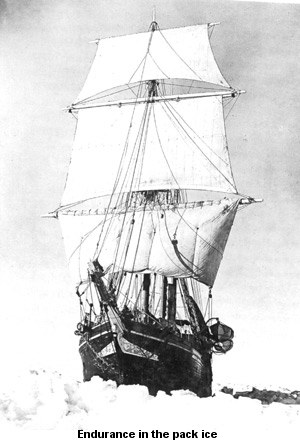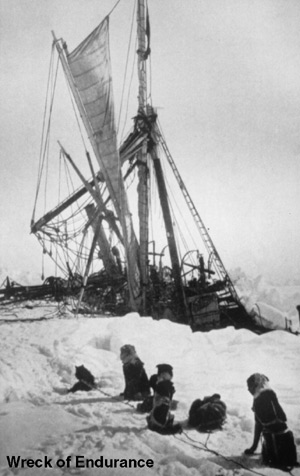
| Glasgow Digital Library | Voyage of the Scotia | BRUCE | PEOPLE | SHIP | ANTARCTIC | INDEX |
|---|
Endurance - a 300-ton barquentine
Lars Christensen and Adrien Gerlache had had a special ship built in Norway for 'polar safaris', but couldn't raise enough funds. Their ship, Polaris, was extremely strong but built more like a yacht than the traditional whalers used in polar work. She was sold to Shackleton for £11,600 and renamed Endurance.
As Endurance headed south, a German battle fleet defeated a British fleet off the west coast of South America in the Battle of Coronel. They were thought to be heading around Cape Horn to the Falkland Islands, so Shackleton headed for South Georgia.

Shackleton stopped at the whaling town of Grytviken on 5 November 1914. He was expected to stay a few days but the whalers told him that the pack ice was further north than they could ever recall. The Norwegians were astonished that only three of Shackleton's party could ski and that they had no trained dog handler on board. Shackleton hoped to copy Amundsen and use dogs for the crossing.
Shackleton sailed for the south after a month's delay and on 8 December pack ice was seen at 57°S. (This was the day the British fleet took revenge for the Battle of Coronel by sinking the German fleet off the Falkland Islands.) On 11 December Shackleton entered the pack ice 1,000km (600 miles) from the Antarctic continent.
Good progress was made through the pack and on 10 January 1915 Coats Land was sighted and Bruce's furthest south 74°01'S reached. New land was discovered as they moved south which they called the 'Caird Coast'. Progress was then barred by the ice barrier 300km (200 miles) from their destination of Vahsel Bay.
On 15 January the ice opened up and Endurance proceeded south for 190km (120 miles) to within 120km (80 miles) of her destination. On 19 January she was beset in ice at 76°30'S 31°30'W. The Weddell Sea had been a trap for many ships with its moving ice pack - Bruce's ship Scotia had been beset in this area but had escaped, Filchner's ship Deutschland had been trapped for nine months and in 1903 Nordenskjold's ship Antarctic had been crushed and sunk.
Endurance drifted to within 100km (60 miles) of her destination, but that was too far to ship her 50 tons of stores. On 21 February Endurance reached 76°58'S and began to drift north.

| Glasgow Digital Library | Voyage of the Scotia | BRUCE | PEOPLE | SHIP | ANTARCTIC | INDEX |
|---|